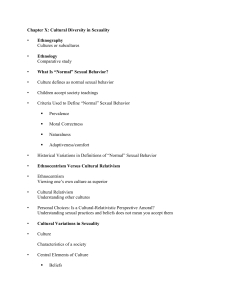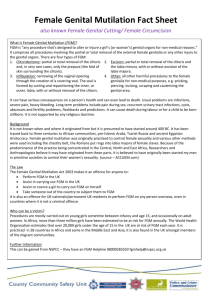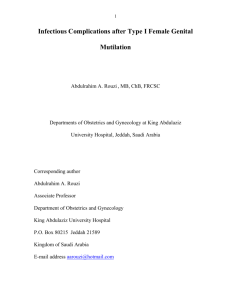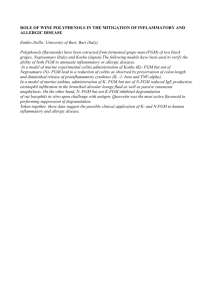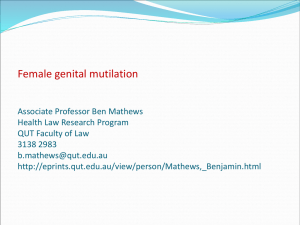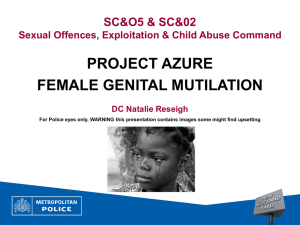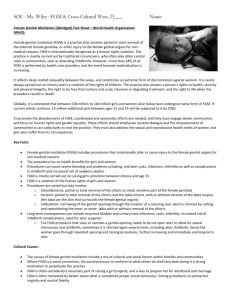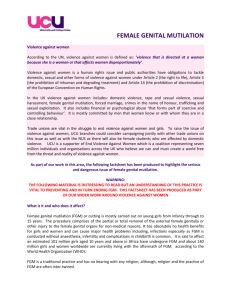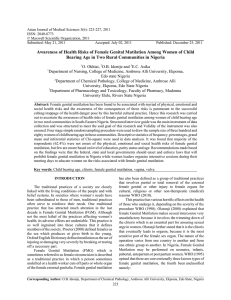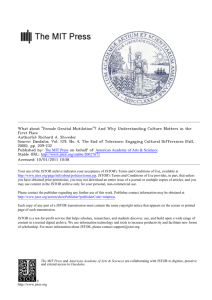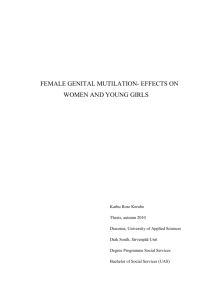On Abolishing FGM - Human Rights Brief
advertisement
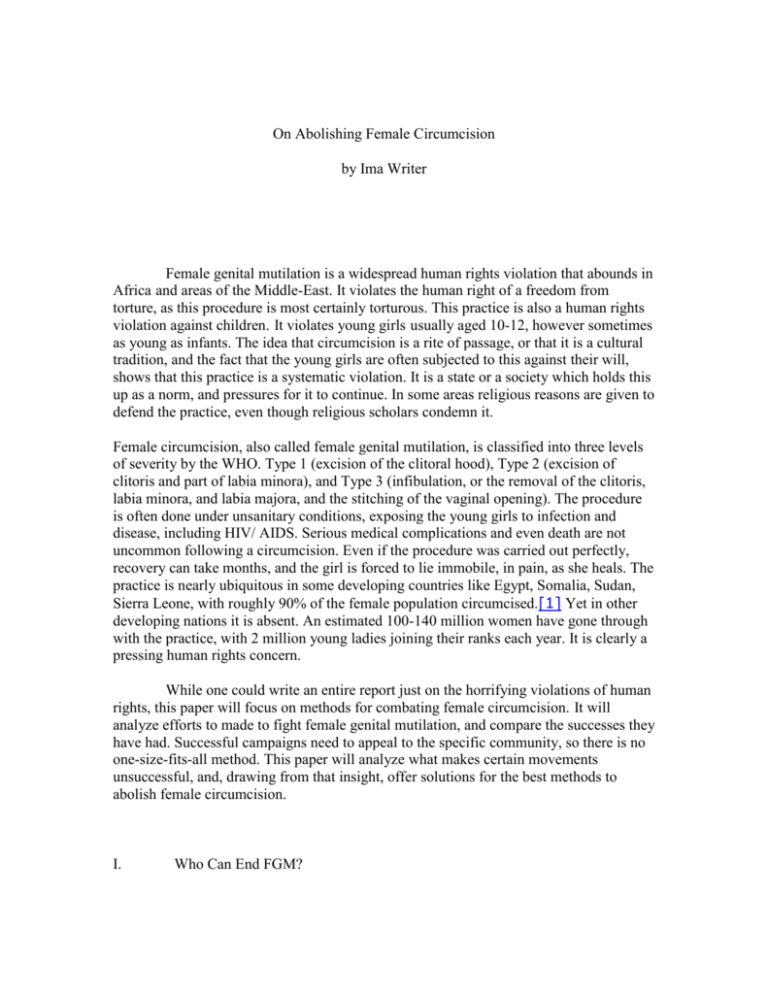
On Abolishing Female Circumcision by Ima Writer Female genital mutilation is a widespread human rights violation that abounds in Africa and areas of the Middle-East. It violates the human right of a freedom from torture, as this procedure is most certainly torturous. This practice is also a human rights violation against children. It violates young girls usually aged 10-12, however sometimes as young as infants. The idea that circumcision is a rite of passage, or that it is a cultural tradition, and the fact that the young girls are often subjected to this against their will, shows that this practice is a systematic violation. It is a state or a society which holds this up as a norm, and pressures for it to continue. In some areas religious reasons are given to defend the practice, even though religious scholars condemn it. Female circumcision, also called female genital mutilation, is classified into three levels of severity by the WHO. Type 1 (excision of the clitoral hood), Type 2 (excision of clitoris and part of labia minora), and Type 3 (infibulation, or the removal of the clitoris, labia minora, and labia majora, and the stitching of the vaginal opening). The procedure is often done under unsanitary conditions, exposing the young girls to infection and disease, including HIV/ AIDS. Serious medical complications and even death are not uncommon following a circumcision. Even if the procedure was carried out perfectly, recovery can take months, and the girl is forced to lie immobile, in pain, as she heals. The practice is nearly ubiquitous in some developing countries like Egypt, Somalia, Sudan, Sierra Leone, with roughly 90% of the female population circumcised.[1] Yet in other developing nations it is absent. An estimated 100-140 million women have gone through with the practice, with 2 million young ladies joining their ranks each year. It is clearly a pressing human rights concern. While one could write an entire report just on the horrifying violations of human rights, this paper will focus on methods for combating female circumcision. It will analyze efforts to made to fight female genital mutilation, and compare the successes they have had. Successful campaigns need to appeal to the specific community, so there is no one-size-fits-all method. This paper will analyze what makes certain movements unsuccessful, and, drawing from that insight, offer solutions for the best methods to abolish female circumcision. I. Who Can End FGM? Who has the power to enact change? For one, national governments have the power to outlaw it and enforce penalties for anyone who commits it. Second, religious leaders and organizations can decry the practice. Islamic officials have declared that female circumcision is contrary to Shariah law and has no basis in the Koran.[2] This announcement undermines the legitimacy of those that claim to practice FGM in accordance with religious law. Third, nongovernmental and intl. organizations have the ability to end this tradition. Training programs and workshops are designed to educate villagers about the risks and push for reform. II. Models to End FGM There have not been active, organized efforts to end female circumcision in many of the states where it exists. For this reason, I will primarily compare the different existing models of abolition. One model is the Egypt model, where there has been powerful social movements led by government, religious leaders, and activists. The Egypt model encompasses a wide array of allies, combining parts of the above approaches to create a powerful front dedicated to one unified purpose. Under the Egypt model, female circumcision is banned.[3] The ban means that no member of the medical community can perform the practice without punishment.[4] The media figures largely in Egypt’s efforts; heavy publicity given to abolishing FGM has helped shatter social taboos against public discussion. A second model is the Tostan model in Senegal, where an educational non-governmental organization in cooperation with UNICEF and the Senegalese government sponsored a two year education program. It informed villagers about the health risks and nonuniversality of the custom and this led to villagers publicly pledging not to continue with their efforts in endeavoring in the practice.[5] The public pledge spread to neighboring villages as well, and has seriously reduced occurrences. The hallmark of this program is that it is educational, not coercive, and does not try to force a change in behavior—they allows women to decide for themselves whether or not to subject their daughters to it. Villagers took it upon themselves to end the practice they were not forced to end it. A third model is the Alternative Rites model. The educational program itself is supposed to substitute FGM as the rite of passage into womanhood. Under this model, an ‘alternative rite of passage’ of education about the history, cultural relevance, and risks of female circumcision is meant to replace the traditional practice.[6] This model faces a difficult task, as it tries to promote change from the bottom-up, it’s advantage lies in the fact that NGOs can affect more of a change than might occur from a top-down government ban where laws are laxly enforces. There are two additional models which I’ll mention only briefly, because they try to curb, not abolish, the practice. The model of ‘Sterilising the Practice’ is not an effort to end female circumcision. Rather, it aims to curb the risk of infection and disease by sterilising the tools used. The medical community oversees the procedure, nurses are dispatched to teach proper, sanitary techniques. The Kenyan government supported this model, and their Ministry of Health enforced the changes. [7] Nonetheless, the Sterilise the Practice model reveals that the practice is in many ways so culturally accepted that the movement is not trying to abolish it, it is only concerned with making it hygienic. This practice peaked during the 1990’s AIDS epidemic, and is largely discredited today. The UNFPA, UNICEF, the WHO and several African governments have all declared that no member of medical community should perform female circumcision under any circumstances,[8] so this movement lost a lot of credibility. The second nonabolition model is the ‘Less Severe’ model, where people that have received education on the topic opt to continue carrying it out, but change the kind of circumcision. Instead of performing the radical Type 2, Infibulation, villagers will adopt Type 1, where the clitoral hood is nicked or excised. Like the Sterilise the Practice model, the Less Severe model modifies behavior, making it less invasive and dangerous, yet it shows that the practice is so culturally entrenched that the movement is to reform, not abolish, female circumcision.   Outlawing the practice is not enough. In the trouble spots in the Middle East and Africa laws are unclear. Bans often restrict the medical community from practicing female circumcision, but do not outlaw it for everyone. Many groups who continue practicing it are simply unaware of any anti-FGM legislation.[9] This is because of no awareness, as many countries with female circumcision laws on the books do not enforce them. In order for the practice to be abolished, serious government efforts need to be supplemented by the citizens’s support. Traditional beliefs and social views must be changed so that people will cooperate with the anti-FGM movement. The biggest obstacle to changing these beliefs is that public discussion of female genital cutting is often a taboo because social workers for nongovernmental organizations have found that when these taboos are broken and this matter is discussed, members of practicing villages are increasingly against the practice of female genital mutation. The taboo nature has kept the extent of the practice a well kept secret. III. Un-covering FGM in Other Areas Before female genital mutilation can be abolished, it must be realised by the world how widespread it is. It’s important to note that FGM exists beyond Africa. The practice is prevalent in the Middle East, though this fact is drastically understated. Scholars Thomas van der Osten-Sacken and Thomas Uwer wrote a paper on the connection between Islam and FGM in which they questioned how Egypt, which is in Africa but is historically Arab and is culturally linked to the Middle East, could have such a high percentage of FGM, but neighboring nations in the Middle East could have so little. Data on the amount of FGM in the Middle East is not very reliable, as there has not been enough independent field research. Many of the statistics come from national governments who are dedicated to hiding this practice from international eyes. Nongovernmental organizations typically have reliable numbers, as they don’t have a agenda like the governments do. Unfortunately and lamentably, in some instances, NGOs simply accept the numbers which are provided by governments without undertaking any independent research. This accounts for the frustrating inconsistencies in data. For instance, Amnesty International only cities a few areas in Yemen as having FGM. But UNICEF reports that in addition to Yemen the practice occurs in Jordan, Gaza, Oman, and Iraqi Kurdistan.[10] What accounts for this disparity? UNICEF based their figures on field research, which uncovered the disturbing truth that FGM is far more widespread than is typically known. A lack of independent field research in the past led to an underestimation of the degree to which FGM was practiced in the Middle East. The focus of international attention has previously been solely on Africas’ abuse, however some shocking discoveries have been brought to light by recent NGO. In 2003, A German-Austrian NGO called WADI began working to bring medical help to Kurdish areas of Iraq. Their all-female medical teams were able to gain the trust of the insular community of Kurds in the Garmian region of Iraq. Eventually, women confided that they had been subjected to a particularly unhygienic form of FGM - broken glass, ash, and mud. WADI’s research found that there was a female genital cutting rate of 58.7% in the Ganmian region. This discovery was alarming because Iraq had previously been unrecognized as a haven of FGM. In Irbil and Kirkuk, other governorates of Iraq, similar statistics were revealed.[11] WADI also found that most women perceive the practice as ‘normal,’ and see FGM as a religious obligation. How widespread is Female Genital Cutting throughout the Middle East? There is no conclusive evidence, because of the fact that Middle East governments deny it’s existence, and there has not been any independent NGO work. It certainly appears that WADI’s discovery would just be the tip of the iceberg; as the reasons for its practice in Iraqi Kurdistan are the same reasons it is practiced in other regions. … V. Discrimination Against Women Female Genital Cutting denies women their full humanity in order to control her sexuality. There is an indication of male oppression of women in societies where the reason ‘controlling female sexuality’ is given. This oppression can be combated in two ways. First, like the health education programs, villagers in FGM areas need to learn that FGM does not guarantee chastity or prevent homosexuality. Many parents agree to have their daughters undergo genital cutting in good faith mistakenly believing it will prevent immoral behavior. Denouncing this superstition will help end FGM. Second women need to become empowered by their societies through increased education and higher socioeconomic statuses. Once their statuses are higher, subordination practices like FGM will become less acceptable. … VII. Government Action and Inaction There is a discrepancy between the stated goals of international forums and government action at the national level The AU has a goal to end female genital mutilation on the continent, and the UN General Assembly Special Session on Children set a goal of total eradication by 2010. On October 26, 2005, the Protocol on the Rights of Women in Africa, or Maputo Protocol, came in force after being ratified by 15 AU member states over the course of 2 years. Art. 5 of the Maputo Protocol prohibits the practice, and aims to end them using legislation and sanctions. The ratification period took a long time, but the African Union’s threat of sanctions on violating nations as well as governments concerns about there national reputations was an effective drive for governments to sign. The focused efforts of the AU have brought the issue significant attention, that most African governments have been reluctant to do. It has been made not legal by 16 African countries.[30] Making the practice not legal is a positive step, but sadly these laws are often not enforced. Only girls below the age of 18 are covered by the Kenyan law, and even then it is largely unobserved. In Tanzania, antiFGM laws are violated, girls have bled to death during the operation but no charges were ever brought against the circumciser.[31] Some of these violations are not flagrant – there is a serious lack of awareness. Most ethnic groups who practice genital cutting are unaware that the practice is illegal.[32] Yet in some instances, the law has been seriously observed. In Uganda, where FGM is outlawed by the constitution and taken seriously, the number of occurrences dropped by nearly 75% in a four year period, from 1,100 in 1998 to 647 in 2002.[33] Directly connected to Uganda’s success is its public awareness campaign. The government hosts an annual awareness day to addresse the issue. Additionally, NGOs and religious organizations have worked in at the village level in Uganda, spreading awareness.[34] The conclusions that one can’t help but to draw from thus is that government action is necessary; but not sufficient. This issue runs deeper then other crimes. Religious and cultural traditions seemingly legitimate the problem, while poverty and lack of awareness keep the tradition growing. There is none reason why FMG continues - there are multiple reasons that reinforce each other Some of the reasons have become blurred over time, like religious obligations. Movements to end genital cutting take time and are different for each region. In closing, here are seven conclusions about combating female genital mutilation: 1. International forums, like the UN must compel governments to end this practice. The fear of international humiliation or possibly trade sanctions, as the African Union showed, can be successful in exacting cooperation and bullying governments to actually enforce their laws. 2. At the very least, governments must be persuaded by the UN to allow international organizations to carry out independent field research. Only then will we know the extent of the practice in the Middle East and other regions, and only then can this issue be addressed. 3. Awareness campaigns are necessary. Egypt’s use of the media in their campaign is breaking taboos, which is a necessity. Uganda’s National FMG Awarness Day and significant media attention are responsible for high awareness and its high success in ending FMG. 5. The relationship with religion must not be overlooked. Islamic organizations like the Muslim Womens Group must use awareness campaigns to clarify that female genital cutting goes against Islamic tradition and work to discredit the clerics who advocate it. A lack of awareness is the crux of the problem, these groups must seek media attention in order to spread it’s important message. 5. The socioeconomic reasons for FMG can be solved. Kenya’s campaign to give capital to circumcisers in order to find new work is laudable. It has been successful because it attacks the root of the problem. The African Union should exert diplomatic pressure on other governments to adopt similar policies. 6. Alternative Rights must be developed to have symbolic, cultural resonance. The Nongovernmental Organizations who create the new rights will have to specifically tailor a right for each region. 7. The UN and AU should encourage governments to start programs that start Public Pledge campaigns. Public Pledges are a simple and extremely effective way to enact change. [NOTE: there is no need to edit the citations; these are here so you can see how the author supported assertions] [1] “Small Revolution in Cairo,” Amira El Ahl, New York Times, Dec. 6, 2006 [2] “What is missing? Female Genital Surgeries in Eritrea,” Lyda Favali, Global Jurist Froniters, April 20, 2001 [3] “Egypt Forbids Female Circumcision,” Magdi Abdelhadi, BBC News June 28, 2007 [4] “The Practice of Female Genital Mutilation,” Karen Ann Gajewski, The Humanist, Nov-Dec 2007 [5] Gerry Mackie, “Ending Footbinding and Infibulation: A Convention Account.” AmericanSociological-Review; Dec. 1996, p. 999-1017 [6] “Introducing Alternative Rites of Passage,” Miroslava Przak, Africa Today, Summer 2007 [7] Introducing Alternative Rites of Passage,” Miroslava Przak, Africa Today, Summer 2007 [8] United Nations Population Fund, “A Holistic Approach to the Abandonment of Female Genital Mutilation/Cutting.” 2007. [9] Women’s International Network News, “Tanzania: Law Against Female Genital Mutilation Not Enforced.” Summer 2003, Vol. 29, Issue 3, p. 28 [10] Thomas von der Osten-Sacken, Thomas Uwer. “Is Female Genital Mutilation an Islamic Problem?” Middle East Quarterly; Winter 2007, Vol. 14 Issue 1 [11] Thomas von der Osten-Sacken, Thomas Uwer. “Is Female Genital Mutilation an Islamic Problem?” Middle East Quarterly; Winter 2007, Vol. 14 Issue 1 … [30] Wairagala Wakabi, “Africa Battles to Make Female Genital Mutilation History.” The Lancet, Vol 369 March 31, 2007 [31] Women’s International Network News, “Tanzania: Law Against Female Genital Mutilation Not Enforced.” Summer 2003, Vol. 29, Issue 3, p. 28 [32] Women’s International Network News, “Tanzania: Law Against Female Genital Mutilation Not Enforced.” Summer 2003, Vol. 29, Issue 3, p. 28 [33] Rebecca Buckwater, “No End in Sight: Female Mutilation Unabated.” Harvard International Review, Vol. 27, Spring 2005 [34] Rebecca Buckwater, “No End in Sight: Female Mutilation Unabated.” Harvard International Review, Vol. 27, Spring 2005
